Mastering of NIL Stamps with Undercut T-Shaped Features from Single Layer to Multilayer Stamps
Abstract
1. Introduction
2. Materials and Methods
2.1. Single Layer Undercut Masters
2.2. Multilayer Undercut Masters
3. Results
4. Conclusions
Author Contributions
Funding
Data Availability Statement
Conflicts of Interest
References
- Vukusic, P.; Sambles, J.R.; Lawrence, C.R.; Wootton, R.J. Quantified Interference and Diffraction in Single Morpho Butterfly Scales. Proc. R. Soc. B Biol. Sci. 1999, 266, 1403–1411. [Google Scholar] [CrossRef]
- Vukusic, P.; Sambles, J.R. Photonic Structures in Biology. Nature 2003, 424, 852–855. [Google Scholar] [CrossRef] [PubMed]
- Fernandez, A.; Francone, A.; Thamdrup, L.H.; Johanson, A.; Bilenberg, B.; Nielsen, T.; Guttmann, M.; Torres, C.M.S.; Kehagias, N. Design of Hierarchical Surfaces for Tuning Wetting Characteristics. Acs Appl. Mater. Interfaces 2017, 9, 7701–7709. [Google Scholar] [CrossRef] [PubMed]
- Kirchner, R.; Guzenko, V.A.; Rohn, M.; Sonntag, E.; Mühlberger, M.; Bergmair, I.; Schift, H. Bio-Inspired 3D Funnel Structures Made by Grayscale Electron-Beam Patterning and Selective Topography Equilibration. Microelectron. Eng. 2015, 141, 107–111. [Google Scholar] [CrossRef]
- Liddle, J.A.; Gallatin, G.M. Nanomanufacturing: A Perspective. ACS Nano 2016, 10, 2995–3014. [Google Scholar] [CrossRef]
- Jiang, T.; Guo, Z.G.; Liu, W.M. Biomimetic Superoleophobic Surfaces: Focusing on Their Fabrication and Applications. J. Mater. Chem. A 2015, 3, 1811–1827. [Google Scholar] [CrossRef]
- Luong-Van, E.; Rodriguez, I.; Low, H.Y.; Elmouelhi, N.; Lowenhaupt, B.; Natarajan, S.; Lim, C.T.; Prajapati, R.; Vyakarnam, M.; Cooper, K. Review: Micro-and Nanostructured Surface Engineering for Biomedical Applications. J. Mater. Res. 2013, 28, 165–174. [Google Scholar] [CrossRef]
- Khan, S.; Lorenzelli, L.; Dahiya, R.S. Technologies for Printing Sensors and Electronics over Large Flexible Substrates: A Review. IEEE Sens. J. 2015, 15, 3164–3185. [Google Scholar] [CrossRef]
- Busa, C.; Rickard, J.J.S.; Chun, E.; Chong, Y.; Navaratnam, V.; Oppenheimer, P.G. Tunable Superapolar Lotus-to-Rose Hierarchical Nanosurfaces via Vertical Carbon Nanotubes Driven Electrohydrodynamic Lithography. Nanoscale 2017, 9, 1625–1636. [Google Scholar] [CrossRef] [PubMed]
- Schift, H. Nanoimprint Lithography: An Old Story in Modern Times? A Review. J. Vac. Sci. Technol. B Microelectron. Nanometer Struct. 2008, 26, 458–480. [Google Scholar] [CrossRef]
- Möllenbeck, S.; Bogdanski, N.; Wissen, M.; Scheer, H.C.; Zajadacz, J.; Zimmer, K. Investigation of the Separation of 3D-Structures with Undercuts. Microelectron. Eng. 2007, 84, 1007–1010. [Google Scholar] [CrossRef]
- Goh, W.H.; Hashimoto, M. Fabrication of 3D Microfluidic Channels and In-Channel Features Using 3D Printed, Water-Soluble Sacrificial Mold. Macromol. Mater. Eng. 2018, 303. [Google Scholar] [CrossRef]
- Matsumoto, H.; Okabe, T.; Taniguchi, J. Microchannel Fabrication via Ultraviolet-Nanoimprint Lithography and Electron-Beam Lithography Using an Ultraviolet-Curable Positive-Tone Electron-Beam Resist. Microelectron. Eng. 2020, 226, 111278. [Google Scholar] [CrossRef]
- An, J.H.; Choi, J.S.; Kang, S.M. Reliable replication molding process for robust mushroom-shaped microstructures. J. Korean Soc. Precis. Eng. 2020, 37, 855–860. [Google Scholar] [CrossRef]
- Finn, A.; Hensel, R.; Hagemann, F.; Kirchner, R.; Jahn, A.; Fischer, W.-J. Geometrical Properties of Multilayer Nano-Imprint-Lithography Molds for Optical Applications. Microelectron. Eng. 2012, 98, 284–287. [Google Scholar] [CrossRef]
- Kirchner, R.; Chidambaram, N.; Schift, H. Benchmarking Surface Selective Vacuum Ultraviolet and Thermal Postprocessing of Thermoplastics for Ultrasmooth 3-D-Printed Micro-Optics. Opt. Eng. 2018, 57. [Google Scholar] [CrossRef]
- Zimmer, K.; Zajadacz, J.; Fechner, R.; Dhima, K.; Scheer, H.-C. Fabrication of Optimized 3D Microstructures with Undercuts in Fused Silica for Replication. Microelectron. Eng. 2012, 98, 163–166. [Google Scholar] [CrossRef]
- Mayer, A.; Rond, J.; Staabs, J.; Leifels, M.; Zajadacz, J.; Ehrhardt, M.; Lorenz, P.; Sunagawa, H.; Hirai, Y.; Zimmer, K.; et al. Multiple Replication of Hierarchical Structures from Polymer Masters with Anisotropy. J. Vac. Sci. Technol. B Nanotechnol. Microelectron. 2019, 37. [Google Scholar] [CrossRef]
- Steinberg, C.; Rumler, M.; Runkel, M.; Papenheim, M.; Wang, S.; Mayer, A.; Becker, M.; Rommel, M.; Scheer, H.-C. Complex 3D Structures via Double Imprint of Hybrid Structures and Sacrificial Mould Techniques. Microelectron. Eng. 2017, 176, 22–27. [Google Scholar] [CrossRef]
- Okabe, T.; Maebashi, H.; Taniguchi, J. Ultra-Violet Nanoimprint Lithography-Compatible Positive-Tone Electron Beam Resist for 3D Hybrid Nanostructures. Microelectron. Eng. 2019, 213, 6–12. [Google Scholar] [CrossRef]
- Alameda, M.T.; Osorio, M.R.; Hernández, J.J.; Rodríguez, I. Multilevel Hierarchical Topographies by Combined Photolithography and Nanoimprinting Processes to Create Surfaces with Controlled Wetting. Acs Appl. Nano Mater. 2019, 2, 4727–4733. [Google Scholar] [CrossRef]
- Moharana, A.R.; Außerhuber, H.M.; Mitteramskogler, T.; Haslinger, M.J.; Mühlberger, M.M. Multilayer Nanoimprinting to Create Hierarchical Stamp Masters for Nanoimprinting of Optical Micro-and Nanostructures. Coatings 2020, 10, 301. [Google Scholar] [CrossRef]
- Deng, J.; Zhou, H.; Dong, J.; Cohen, P. Three-Dimensional Nanomolds Fabrication for Nanoimprint Lithography. In Procedia Manufacturing; Fratini, L., Wang, L., Ragai, I., Eds.; Elsevier, B.V.: Amsterdam, The Netherlands, 2019; Volume 34, pp. 228–232. [Google Scholar]
- Ofir, Y.; Moran, I.W.; Subramani, C.; Carter, K.R.; Rotello, V.M. Nanoimprint Lithography for Functional Three-Dimensional Patterns. Adv. Mater. 2010, 22, 3608–3614. [Google Scholar] [CrossRef] [PubMed]
- Mühlberger, M.; Rohn, M.; Danzberger, J.; Sonntag, E.; Rank, A.; Schumm, L.; Kirchner, R.; Forsich, C.; Gorb, S.; Einwögerer, B.; et al. UV-NIL Fabricated Bio-Inspired Inlays for Injection Molding to Influence the Friction Behavior of Ceramic Surfaces. Microelectron. Eng. 2015, 141, 140–144. [Google Scholar] [CrossRef]
- Waid, S.; Wanzenboeck, H.D.; Muehlberger, M.; Bertagnolli, E. Optimization of 3D Patterning by Ga Implantation and Reactive Ion Etching (RIE) for Nanoimprint Lithography (NIL) Stamp Fabrication. Microelectron. Eng. 2012, 97, 105–108. [Google Scholar] [CrossRef]
- Waid, S.; Wanzenboeck, H.D.; Muehlberger, M.; Gavagnin, M.; Bertagnolli, E. Generation of 3D Nanopatterns with Smooth Surfaces. Nanotechnology 2014, 25. [Google Scholar] [CrossRef]
- Schleunitz, A.; Schift, H. Fabrication of 3D Nanoimprint Stamps with Continuous Reliefs Using Dose-Modulated Electron Beam Lithography and Thermal Reflow. J. Micromech. Microeng. 2010, 20. [Google Scholar] [CrossRef]
- Schrittwieser, S.; Haslinger, M.J.; Mitteramskogler, T.; Mühlberger, M.; Shoshi, A.; Brückl, H.; Bauch, M.; Dimopoulos, T.; Schmid, B.; Schotter, J. Multifunctional Nanostructures and Nanopocket Particles Fabricated by Nanoimprint Lithography. Nanomaterials 2019, 9, 1790. [Google Scholar] [CrossRef]
- Burgsteiner, M.; Müller, F.; Lucyshyn, T.; Kukla, C.; Holzer, C. Influence of the Process Parameters on the Replication of Microstructured Freeform Surfaces. In Proceedings of the AIP Conference Proceedings, Rhodes, Greece, 22–28 September 2014; American Institute of Physics Inc.: College Park, MD, USA, 2014; Volume 1593, pp. 183–188. [Google Scholar]
- Schneider, N.; Zeiger, C.; Kolew, A.; Schneider, M.; Leuthold, J.; Hölscher, H.; Worgull, M. Nanothermoforming of Hierarchical Optical Components Utilizing Shape Memory Polymers as Active Molds. Opt. Mater. Express 2014, 4, 1895–1902. [Google Scholar] [CrossRef][Green Version]
- Meier, T.; Bur, J.; Reinhard, M.; Schneider, M.; Kolew, A.; Worgull, M.; Hölscher, H. Programmable and Self-Demolding Microstructured Molds Fabricated from Shape-Memory Polymers. J. Micromech. Microeng. 2015, 25. [Google Scholar] [CrossRef]
- Yun, J.-G.; Lee, J.D.; Park, B.-G. 3D NAND Flash Memory with Laterally-Recessed Channel (LRC) and Connection Gate Architecture. Solid-State Electron. 2011, 55, 37–43. [Google Scholar] [CrossRef]
- Kim, Y.; Cho, S.; Lee, G.S.; Park, I.H.; Lee, J.D.; Shin, H.; Park, B.G. 3-Dimensional Terraced NAND (3D TNAND) Flash Memory-Stacked Version of Folded NAND Array. Ieice Trans. Electron. 2009, E92-C, 653–658. [Google Scholar] [CrossRef]
- Kouchiyama, A.; Aratani, K.; Takemoto, Y.; Nakao, T.; Kai, S.; Osato, K.; Nakagawa, K. High Resolution Blue Laser Mastering with Inorganic Photoresist. In Proceedings of the International Symposium on Optical Memory and Optical Data Storage Topical Meeting, Waikoloa, HI, USA, 7–11 July 2002; pp. 27–29. [Google Scholar]
- Raoux, S.; Rettner, C.T.; Jordan-Sweet, J.L.; Kellock, A.J.; Topuria, T.; Rice, P.M.; Miller, D.C. Direct Observation of Amorphous to Crystalline Phase Transitions in Nanoparticle Arrays of Phase Change Materials. J. Appl. Phys. 2007, 102. [Google Scholar] [CrossRef]
- Meinders, E.R.; Rastogi, R.; Van Der Veer, M.; Peeters, P.; El Majdoubi, H.; Bulle, H.; Millet, A.; Bruls, D. Phase-Transition Mastering of High-Density Optical Media. Jpn. J. Appl. Phys. Part 1 Regul. Pap. Short Notes Rev. Pap. 2007, 46, 3987–3992. [Google Scholar] [CrossRef]
- Giraldo, M.A.; Yoshioka, S.; Liu, C.; Stavenga, D.G. Coloration Mechanisms and Phylogeny of Morpho Butterflies. J. Exp. Biol. 2016, 219, 3936–3944. [Google Scholar] [CrossRef]
- Bergmair, I.; Dastmalchi, B.; Bergmair, M.; Saeed, A.; Hilber, W.; Hesser, G.; Helgert, C.; Pshenay-Severin, E.; Pertsch, T.; Kley, E.B.; et al. Single and Multilayer Metamaterials Fabricated by Nanoimprint Lithography. Nanotechnology 2011, 22. [Google Scholar] [CrossRef] [PubMed]
- Haslinger, M.J.; Mitteramskogler, T.; Kopp, S.; Leichtfried, H.; Messerschmidt, M.; Thesen, M.W.; Mühlberger, M. Development of a Soft UV-NIL Step&repeat and Lift-off Process Chain for High Speed Metal Nanomesh Fabrication. Nanotechnology 2020, 31. [Google Scholar] [CrossRef]
- Wuttig, M.; Yamada, N. Phase-Change Materials for Rewriteable Data Storage. Nat. Mater. 2007, 6, 824–832. [Google Scholar] [CrossRef] [PubMed]
- Mühlberger, M.; Stephan, S.R.; Nees, D.; Moharana, A.; Belegratis, M.R.; Taus, P.; Kopp, S.; Wanzenboeck, H.D.; Prinz, A.; Fechtig, D. Nanoimprint Replication of Biomimetic, Multilevel Undercut Nanostructures. Nanomaterials 2021. accepted. [Google Scholar]
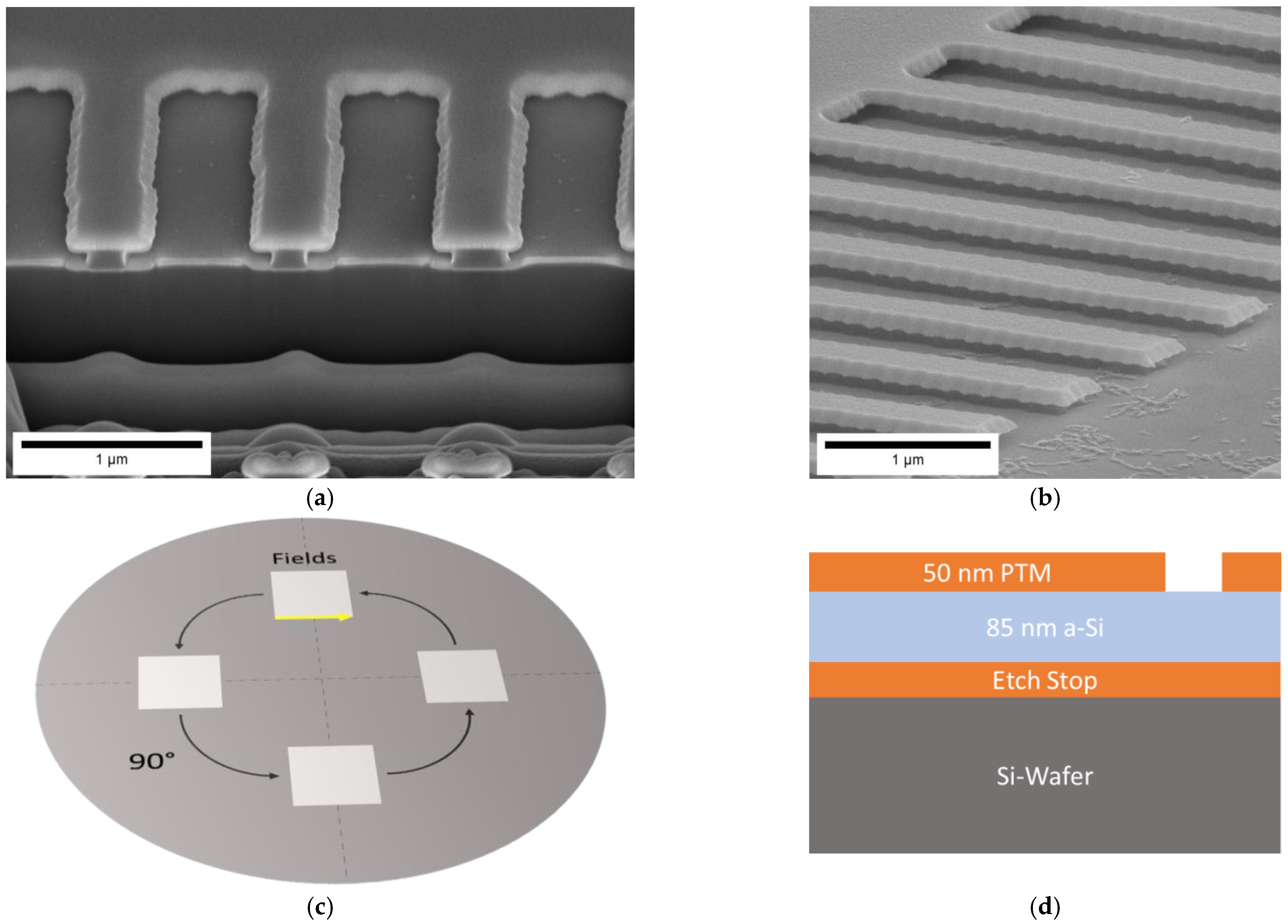
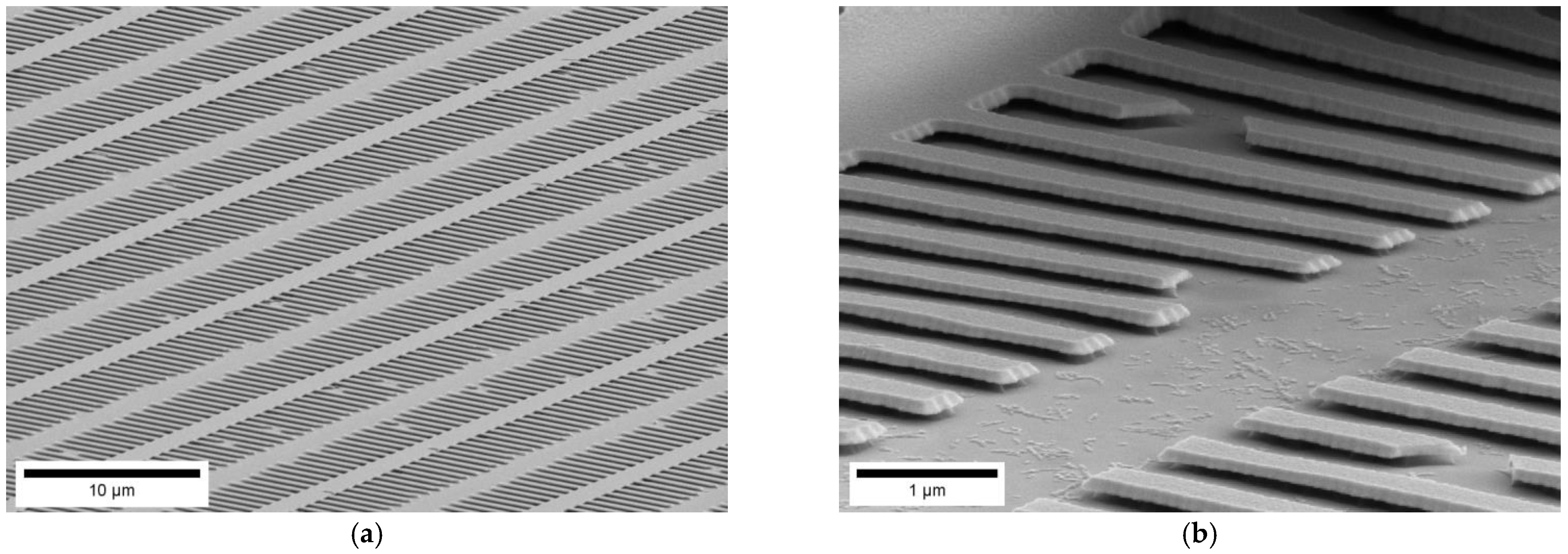
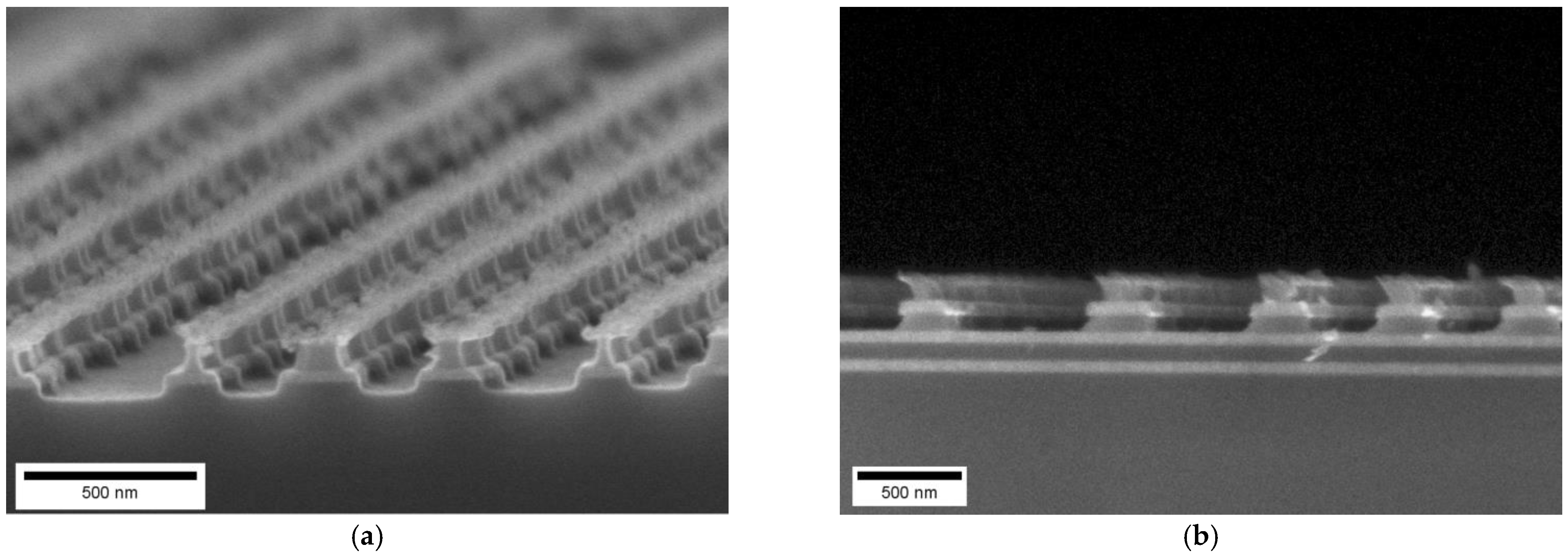

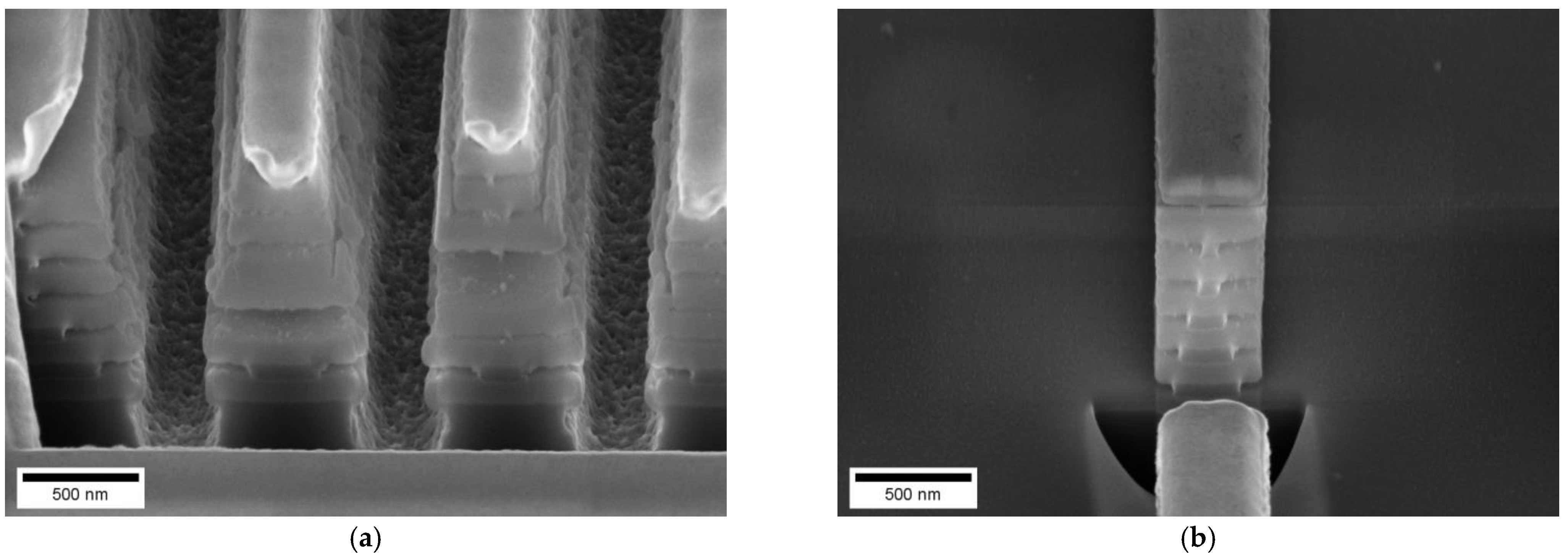
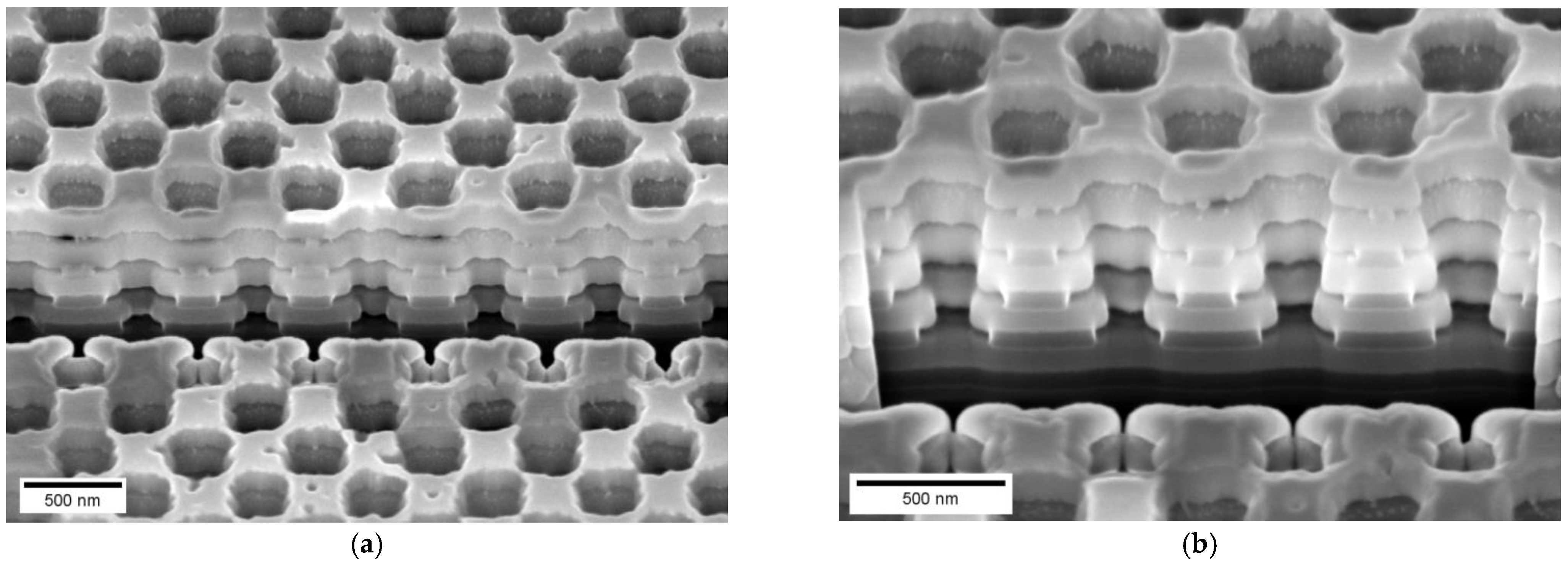
| T-Structure | Single-Layer | Multi-Layer | |||
|---|---|---|---|---|---|
| Patterning | Blu-Ray laser | g-line lithography | e-beam lithography | NIL | |
| Lift-off mask | - | AZ5214E | PMMA | mr-NIL212 | |
| Etch-mask | Inorganic PTM-layer | Au-hardmask | |||
| Etch Step 1 | KOH wet etch | Medium pressure RIE | Low pressure RIE | ||
| Etch Step 2 | High pressure RIE | ||||
Publisher’s Note: MDPI stays neutral with regard to jurisdictional claims in published maps and institutional affiliations. |
© 2021 by the authors. Licensee MDPI, Basel, Switzerland. This article is an open access article distributed under the terms and conditions of the Creative Commons Attribution (CC BY) license (https://creativecommons.org/licenses/by/4.0/).
Share and Cite
Taus, P.; Prinz, A.; Wanzenboeck, H.D.; Schuller, P.; Tsenov, A.; Schinnerl, M.; Shawrav, M.M.; Haslinger, M.; Muehlberger, M. Mastering of NIL Stamps with Undercut T-Shaped Features from Single Layer to Multilayer Stamps. Nanomaterials 2021, 11, 956. https://doi.org/10.3390/nano11040956
Taus P, Prinz A, Wanzenboeck HD, Schuller P, Tsenov A, Schinnerl M, Shawrav MM, Haslinger M, Muehlberger M. Mastering of NIL Stamps with Undercut T-Shaped Features from Single Layer to Multilayer Stamps. Nanomaterials. 2021; 11(4):956. https://doi.org/10.3390/nano11040956
Chicago/Turabian StyleTaus, Philipp, Adrian Prinz, Heinz D. Wanzenboeck, Patrick Schuller, Anton Tsenov, Markus Schinnerl, Mostafa M. Shawrav, Michael Haslinger, and Michael Muehlberger. 2021. "Mastering of NIL Stamps with Undercut T-Shaped Features from Single Layer to Multilayer Stamps" Nanomaterials 11, no. 4: 956. https://doi.org/10.3390/nano11040956
APA StyleTaus, P., Prinz, A., Wanzenboeck, H. D., Schuller, P., Tsenov, A., Schinnerl, M., Shawrav, M. M., Haslinger, M., & Muehlberger, M. (2021). Mastering of NIL Stamps with Undercut T-Shaped Features from Single Layer to Multilayer Stamps. Nanomaterials, 11(4), 956. https://doi.org/10.3390/nano11040956







